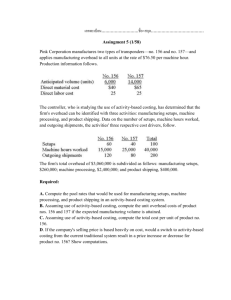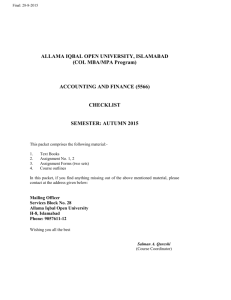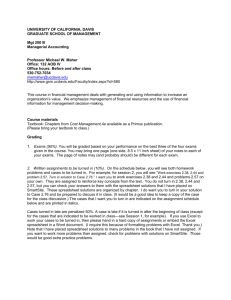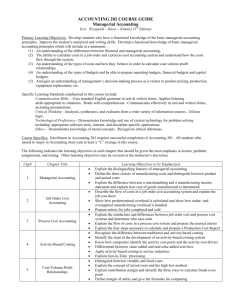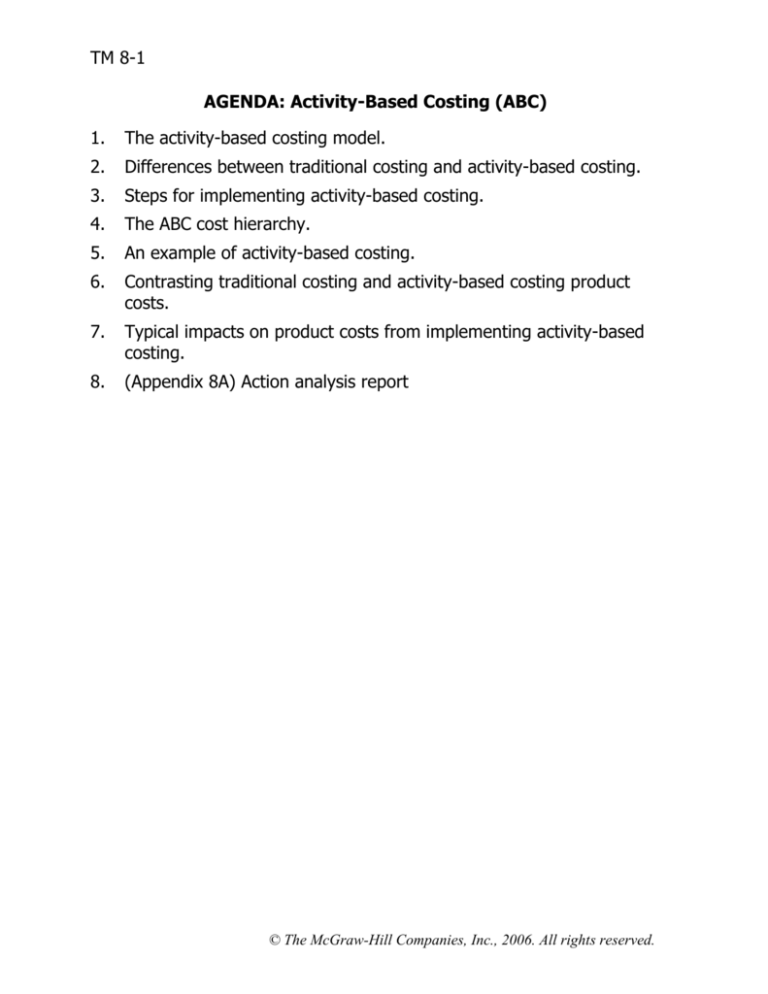
TM 8-1
AGENDA: Activity-Based Costing (ABC)
1.
The activity-based costing model.
2.
Differences between traditional costing and activity-based costing.
3.
Steps for implementing activity-based costing.
4.
The ABC cost hierarchy.
5.
An example of activity-based costing.
6.
Contrasting traditional costing and activity-based costing product
costs.
7.
Typical impacts on product costs from implementing activity-based
costing.
8.
(Appendix 8A) Action analysis report
© The McGraw-Hill Companies, Inc., 2006. All rights reserved.
TM 8-2
ACTIVITY-BASED COSTING MODEL
Cost Objects
(e.g., products, customers, orders)
Activities
Consumption of Resources
Cost
The emphasis is on decision-making and managing activities, not on
assigning costs to products for external financial reports.
© The McGraw-Hill Companies, Inc., 2006. All rights reserved.
TM 8-3
DIFFERENCES BETWEEN TRADITIONAL COSTING
AND ACTIVITY-BASED COSTING
• In traditional costing systems:
• All manufacturing costs are assigned to products whether or not they
are caused by the products.
• Nonmanufacturing costs are not assigned to products—even those
nonmanufacturing costs that are caused by the products.
• The entire facility may have only one overhead cost pool and a single
measure of activity such as direct labor-hours.
• Predetermined overhead rates are based on estimated costs at the
budgeted or expected level of activity.
• In activity-based costing:
• Nonmanufacturing costs, as well as manufacturing costs, may be
assigned to products.
• Some manufacturing costs may be excluded from product costs.
• There are a number of overhead cost pools, each of which has its own
unique measure of activity.
• The allocation bases (i.e., measures of activity) often differ from those
used in traditional costing.
• The activity rates (i.e., overhead rates) may be based on the level of
activity at capacity rather than on the budgeted or expected level of
activity.
© The McGraw-Hill Companies, Inc., 2006. All rights reserved.
TM 8-4
STEPS FOR IMPLEMENTING ACTIVITY-BASED COSTING
1.
Identify and define activities and activity pools.
2.
Wherever possible, directly trace overhead costs to activities and cost
objects.
3.
Allocate costs to activity cost pools.
4.
Calculate activity rates.
5.
Assign costs to cost objects using the activity rates and activity
measures.
6.
Prepare management reports.
© The McGraw-Hill Companies, Inc., 2006. All rights reserved.
TM 8-5
COST HIERARCHY
1.
Unit-level activities are performed each time a unit is produced. The
costs of unit-level activities should be proportional to the number of
units produced.
2.
Batch-level activities are performed each time a batch is handled or
processed, regardless of how many units are in the batch. Costs at the
batch level do not depend on the number of units produced, the
number of units sold, or other unit-level measures of volume.
3.
Product-level activities relate to specific products and typically must be
carried out regardless of how many batches or units of product are
produced or sold.
4.
Customer-level activities relate to specific customers and include
activities such as sales calls, catalog mailings, and general technical
support that are not tied to any specific product.
5.
Organization-sustaining activities are carried out regardless of which
products are produced, how many batches are run, or how many units
are made.
© The McGraw-Hill Companies, Inc., 2006. All rights reserved.
TM 8-6
THE CLASSIC BRASS EXAMPLE
Activity Cost Pools at Classic Brass
Activity Cost Pool
Activity Measure
Customer Orders
Product Design
Order Size
Customer Relations
Other
Number of customer orders
Number of product designs
Machine-hours
Number of active
customers
Not applicable
© The McGraw-Hill Companies, Inc., 2006. All rights reserved.
TM 8-7
THE CLASSIC BRASS EXAMPLE (cont’d)
© The McGraw-Hill Companies, Inc., 2006. All rights reserved.
TM 8-8
THE CLASSIC BRASS EXAMPLE (cont’d)
Exhibit 8-2
Annual Overhead Costs
(both Manufacturing and Nonmanufacturing)
at Classic Brass
Production Department:
Indirect factory wages .....................
Factory equipment depreciation .......
Factory utilities ................................
Factory building lease ......................
$500,000
300,000
120,000
80,000 $1,000,000
Shipping costs* ...................................
40,000
General Administrative Department:
Administrative wages and salaries ....
Office equipment depreciation ..........
Administrative building lease ............
400,000
50,000
60,000
510,000
Marketing Department:
Marketing wages and salaries ...........
Selling expenses ..............................
250,000
50,000
300,000
Total overhead cost .............................
$1,850,000
*Shipping costs are traced directly to customer orders.
© The McGraw-Hill Companies, Inc., 2006. All rights reserved.
TM 8-9
THE CLASSIC BRASS EXAMPLE (cont’d)
Exhibit 8-3
Results of Interviews
Customer
Orders
Production Department:
Indirect factory wages .................
Factory equipment depreciation ....
Factory utilities ............................
Factory building lease ..................
Activity Cost Pools
Product
Customer
Design Order Size Relations
Other
Total
25%
20%
0%
0%
40%
0%
10%
0%
20%
60%
50%
0%
10%
0%
0%
0%
5%
20%
40%
100%
100%
100%
100%
100%
General Administrative Department:
Administrative wages and salaries.
Office equipment depreciation ......
Administrative building lease ........
15%
30%
0%
5%
0%
0%
10%
0%
0%
30%
25%
0%
40% 100%
45% 100%
100% 100%
Marketing Department:
Marketing wages and salaries .......
Selling expenses ..........................
20%
10%
10%
0%
0%
0%
60%
70%
10% 100%
20% 100%
Shipping costs*
*Shipping costs are directly traced to customer orders.
© The McGraw-Hill Companies, Inc., 2006. All rights reserved.
TM 8-10
THE CLASSIC BRASS EXAMPLE (cont’d)
Exhibit 8-4
First-Stage Allocations to Activity Cost Pools
Activity Cost Pools
Customer Product Order Customer
Orders
Design
Size
Relations
Production Department:
Indirect factory wages ................. $125,000 $200,000 $100,000
Factory equipment depreciation ....
60,000
0 180,000
Factory utilities ............................
0 12,000 60,000
Factory building lease ..................
0
0
0
Other
Total
$50,000
0
0
0
$25,000
60,000
48,000
80,000
$500,000
300,000
120,000
80,000
120,000
12,500
0
160,000
22,500
60,000
400,000
50,000
60,000
Shipping costs*
General Administrative Department:
Administrative wages and salaries.
Office equipment depreciation ......
Administrative building lease ........
60,000
15,000
0
20,000
0
0
40,000
0
0
Marketing Department:
Marketing wages and salaries .......
50,000 25,000
0 150,000
25,000
250,000
Selling expenses ..........................
5,000
0
0
35,000
10,000
50,000
Total ............................................. $315,000 $257,000 $380,000 $367,500 $490,500 $1,810,000
*Shipping costs are directly traced to customer orders.
© The McGraw-Hill Companies, Inc., 2006. All rights reserved.
TM 8-11
THE CLASSIC BRASS EXAMPLE (cont’d)
Exhibit 8-5
Computation of Activity Rates
Activity Cost Pools
(a)
Total Cost
Customer orders .........
Product design ...........
Order size ..................
Customer relations ......
Other .........................
(b)
Total Activity
(a) ÷ (b)
Activity Rate
$315,000 1,000 orders
$315 per order
$257,000
200 designs
$1,285 per design
$380,000 20,000 MHs
$19 per MH
$367,500
100 customers $3,675 per customer
Not applicable
$490,500 Not applicable
© The McGraw-Hill Companies, Inc., 2006. All rights reserved.
TM 8-12
THE CLASSIC BRASS EXAMPLE (cont’d)
Exhibit 8–7
Data Concerning the Products Ordered by Windward Yachts
Standard Stanchions
1. This is a standard design that does not require any new design
resources.
2. Four hundred units were ordered during the year, comprising two
separate orders.
3. Each stanchion required 0.5 machine-hour, for a total of 200
machine-hours.
4. The selling price per unit was $34, for a total of $13,600.
5. Direct materials for 400 units totaled $2,110.
6. Direct labor for 400 units totaled $1,850.
7. Shipping costs for the two orders totaled $180.
Custom Compass Housing
1. This is a custom product that requires new design resources.
2. There was only one order for a single unit during the year.
3. The compass housing required 4 machine-hours.
4. The selling price was $650.
5. Direct materials were $13.
6. Direct labor was $50.
7. Shipping costs were $25.
© The McGraw-Hill Companies, Inc., 2006. All rights reserved.
TM 8-13
THE CLASSIC BRASS EXAMPLE (cont’d)
Exhibit 8-8
Computation of Overhead Costs
Activity Cost Pools
(a)
Activity Rate
Standard Stanchions
Customer orders ......... $315
Product design ........... $1,285
Order size ..................
$19
Customer relations ...... $3,675
(b)
Activity
(a) × (b)
ABC Cost
per
per
per
per
order
design
MH
customer
2 orders
0 designs
200 MHs
Not applicable
$630
$0
$3,800
Custom Compass Housing
Customer orders ......... $315 per
Product design ........... $1,285 per
Order size ..................
$19 per
Customer relations ...... $3,675 per
order
design
MH
customer
1 order
1 design
4 MHs
Not applicable
$315
$1,285
$76
© The McGraw-Hill Companies, Inc., 2006. All rights reserved.

